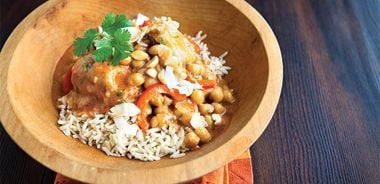Thai Chicken and Red Pepper Curry

Dinner doesn’t have to be complicated. In this dish, the only cooking you need to do is sautéing the onions. After that, it’s just stirring ingredients in a slow cooker and waiting for them to magically become dinner. This curry is intensely warm and soothing after a cold rainy or snowy night.
6 boneless skinless chicken thighs
1/4 cup (60 mL) organic unbleached all-purpose flour (choose quinoa flower for a wheat-free option)
1/4 tsp (1 mL) salt
1/4 tsp (1 mL) freshly ground black pepper
1/2 Tbsp (7 mL) coconut oil
1 onion, chopped
2 garlic cloves, finely minced
14 oz (398 mL) can light coconut milk
2 to 3 Tbsp (30 to 45 mL) red curry paste
2 tsp (10 mL) miso paste
1 tsp (5 mL) raw coconut crystals or brown sugar
14 oz (398 mL) can chickpeas, rinsed and drained
4 kaffir lime leaves or 4 wedges fresh lime
1 red bell pepper, cored and cut into julienne strips
3 cups (750 mL) baby spinach leaves
1 cup (250 mL) fat-free plain Greek yogurt
1/4 cup (60 mL) chopped toasted peanuts
1/4 cup (60 mL) toasted coconut
Cilantro
Dust chicken with flour, salt, and pepper and place in single layer in bottom of 4 to 6 L slow cooker.
Sauté onions and garlic in oil until soft. Scatter over top of chicken. Whisk coconut milk, curry paste, miso, and sugar together in bowl and pour over chicken. Stir in chickpeas and kaffir lime leaves or wedges.
Cover and cook on low for 5 to 7 hours or high for 2 1/2 to 4 hours or until chicken is no longer pink on the inside. Taste and add a little more miso or sugar to taste if you wish. Stir in red pepper strips and continue to cook on high for 20 more minutes. Fold in baby spinach leaves.
Serve over steamed basmati rice and garnish with dollops of yogurt, peanuts, coconut, and cilantro.
Serves 6.
Each serving contains: 302 calories; 22 g protein; 13 g total fat (6 g sat. fat, 0 g trans fat); 25 g total carbohydrates (4 g sugars, 3 g fibre); 346 mg sodium
source: "Slow Cooking", alive #375, January 2014





